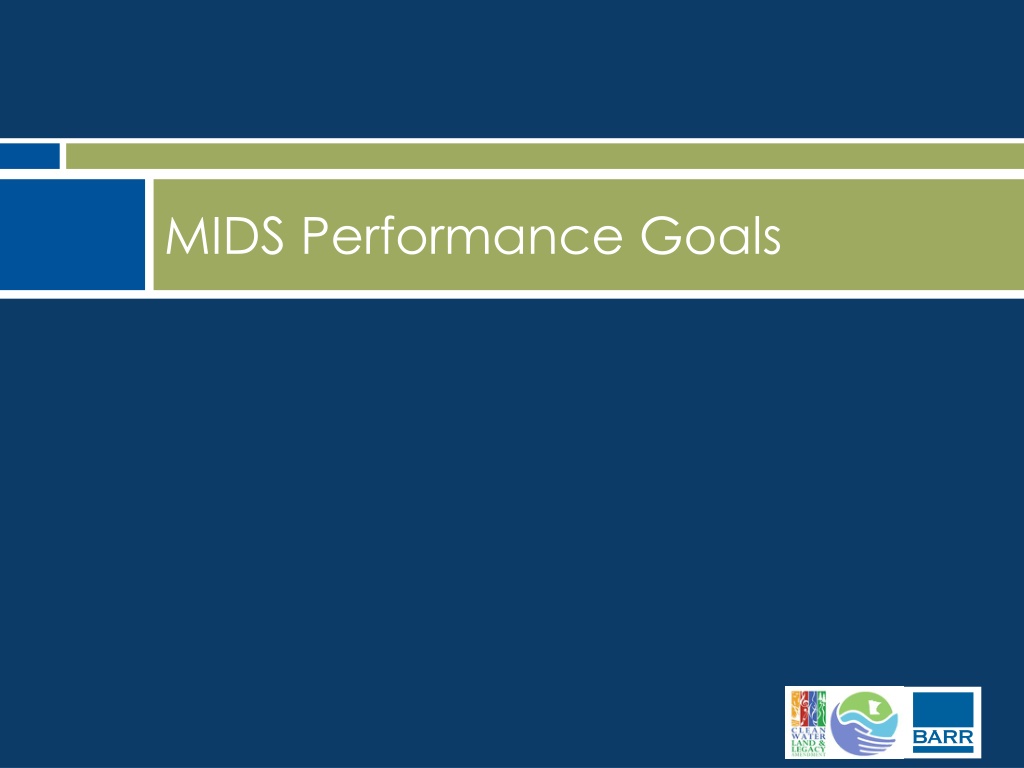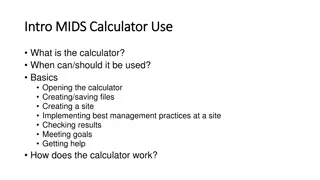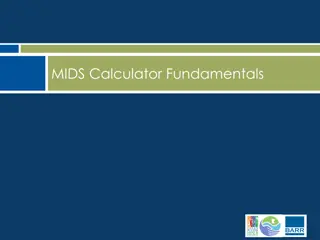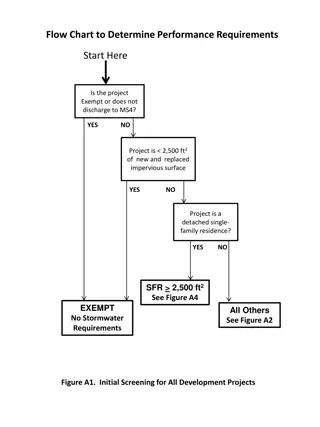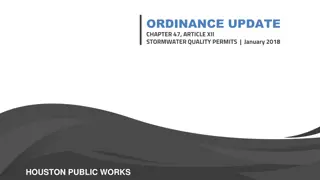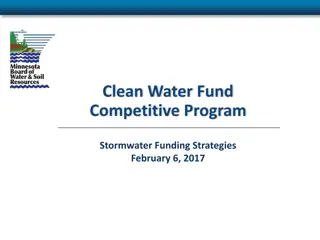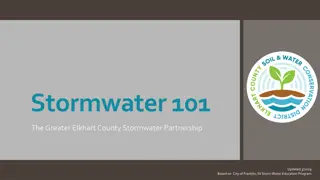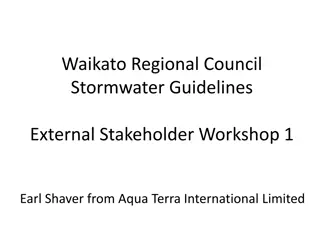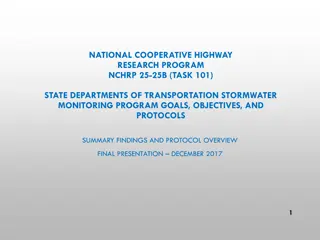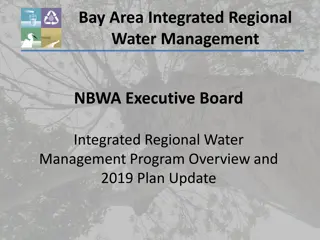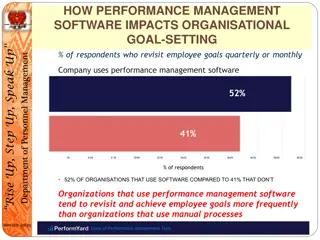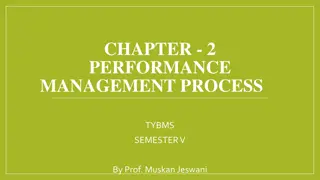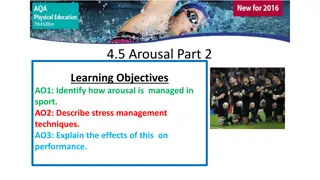Understanding MIDS Performance Goals in Stormwater Management
The Municipal Integrated Design Standards (MIDS) encompass performance goals, flexible treatment options, and a calculator to quantify benefits of Low Impact Development (LID) practices. Learn about the different performance goals, why they vary, and how to determine the applicable goal based on site restrictions. The Design Sequence Flow Chart and MIDS Calculator play crucial roles in achieving compliance with these goals.
Download Presentation

Please find below an Image/Link to download the presentation.
The content on the website is provided AS IS for your information and personal use only. It may not be sold, licensed, or shared on other websites without obtaining consent from the author. Download presentation by click this link. If you encounter any issues during the download, it is possible that the publisher has removed the file from their server.
E N D
Presentation Transcript
Jargon Performance goal: Stormwater standard/rule Flexible Treatment Option (FTO): Alternative performance goal used when conformance to the volume retention performance goal is not feasible or not allowed TP: Total Phosphorus LID: Low Impact Development BMP: Best Management Practices LGU: Local Government Unit
What is MIDS? Four basic components: 1. Performance goals 2. Calculator to standardize and quantify ( credit ) the benefits of LID BMPs 3. Design specifications for a variety of LID BMPs (continuing in Stormwater Manual update) 4. A model MIDS ordinance package
What are the Performance Goals? Retain on site 1.1 of runoff from new and/or fully reconstructed impervious surfaces Most Sites Retain 0.55 of runoff from the new and/or fully reconstructed impervious surfaces AND Remove 75% of the annual TP load FTO 1: Clay, etc. Achieve as much volume reduction as practicable AND Remove 60% of the annual TP load FTO 2: Contam- ination Off-site mitigation FTO 3
Why are there different Performance Goals? Site restrictions might require FTO Different performance goal if site has restrictions (including, but not limited to): zoning/land use requirements karst shallow bedrock slow-draining soils high groundwater contamination
How do I know which performance goal applies? Restrictions included in Design Sequence Flow Chart Use it to Determine Performance Goal
How is the Design Sequence Flow Chart related to the MIDS Calculator? 1. Use Flow Chart to define Performance Goal 2. Once Performance Goal is determined, MIDS Calculator can be used to show compliance
Flexible Treatment Options & MIDS Calculator Defining Performance Goal Starting Performance Goals: New, Nonlinear Developments and Reconstruction/Redevelopment Projects: Retain on site 1.1 inches of runoff from the new and/or fully reconstructed impervious surfaces
Flexible Treatment Options & MIDS Calculator Defining Performance Goal Starting Performance Goals: Linear Projects: Retain on site the larger of 0.55 inches of runoff from the new and fully reconstructed impervious surfaces 1.1 inches of runoff from the net increase in impervious surfaces
Flexible Treatment Options & MIDS Calculator Defining Performance Goal FTO #1: Applicant attempts to comply with the following conditions: 1a Achieve at least 0.55 volume reduction goal, and 1b Remove 75% of the annual TP load, and 1c Options considered and presented shall examine the merits of relocating project elements to address, varying soil conditions and other constraints across the site
Flexible Treatment Options & MIDS Calculator Defining Performance Goal FTO #2: Applicant attempts to comply with the following conditions: 2a Achieve volume reduction to the maximum extent practicable (as determined by the LGU), and 2b Remove 60% of the annual TP load, and 2c Options considered and presented shall examine the merits of relocating project elements to address, varying soil conditions and other constraints across the site.
Flexible Treatment Options & MIDS Calculator Defining Performance Goal FTO #3: Off-site mitigation (including banking or cash or treatment on another project, as determined by the local authority) equivalent to the volume reduction performance goal can be used in areas selected in the following order of preference:
Flexible Treatment Options & MIDS Calculator Defining Performance Goal FTO #3 continued: 1. Locations that yield benefits to the same receiving water as that receiving runoff from the original construction activity 2. Locations within the same DNR catchment area as the original construction activity 3. Locations in the next adjacent DNR catchment area upstream 4. Locations anywhere within the local authorities jurisdiction
Flexible Treatment Options & MIDS Calculator Defining Performance Goal MIDS Calculator defaults to the 1.1 inch volume retention performance goal User can change volume retention performance goal to 0.55 inches (or another goal); the calculator will provide warning that the value has been changed from 1.1 For water quality performance goals, user/reviewer needs to compare calculator results to performance goal FTOs include pollutant reduction goals MIDS Calculator quantifies annual pollutant removals
Question What 4 values are noteworthy in regards to FTOs?
